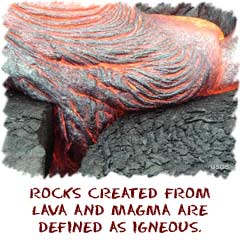Rocks And Minerals
Let's start off with an explanation that rocks and minerals are different things. Rocks are groups of different minerals pushed together and combined. They don't have easy chemical formulas to describe their makeup. A ruby is considered a mineral. It's a nice pretty crystal with the same compounds throughout the object. But the rock that surrounds that ruby has many many different compounds (and even a few pieces of ruby mixed in). There's an easier example that many people can relate to. Think about quartz. On its own (as a mineral) it's a nice pretty crystal. But a piece of granite often has loads of quartz. It's ground up and crushed, but its still bits of quartz. Granite is a rock and quartz is a mineral.
Igneous Rocks
Igneous rocks are the ones that were superheated and originally liquid. They come from the center of the Earth! Not really the center, but they often start their lives below the crust and then get pumped out. There are two basic types of igneous rocks. There are the rocks that make it to the surface (extrusive) and the ones that are stuck in the crust just below the surface (intrusive). These igneous types have all hardened after being molten rock. If you walk around a volcano, you will find those extrusive types. The intrusive types are usually found in areas called plutons and dikes, big old pools of molten rock that were just beneath the surface. Some examples of igneous rock are granite, all volcanic rock, basalt, and obsidian.Metamorphic Rocks
This rock type is created by heat and/or pressure. Even though heat is involved, they didn't start off as molten rock. But. You often find metamorphic rock near volcanoes and sources of super hot rock. The heat from the magma changes all of the rock around it. Try another explanation. Look at the name 'metamorphic.' It looks like the word used to describe insects that go through a metamorphosis. It's the same concept. Some force (heat/pressure) has changed these rocks from one type into a new type. The result is a metamorphic rock. Some examples are marble, jade, slate, and gneiss. Because pressure and heat are involved, these rock types are usually found deep beneath the surface. They are also found near fault lines where plates push against each other and create enormous pressures. Over time, because of the movement of the crust, these metamorphic rocks are pushed to the surface where you can find them every day.Sedimentary Rocks
The last of the big three rock types is probably the rarest... unless you live near the coast. Sedimentary rock types are created when sediment compresses. It's pretty simple. Here's the setup... A river flows through a canyon and picks up a bunch of silt. That sediment and silt runs downstream and deposits where the river ends. It could be in a flood plain or a valley, but we're using a coastline as an example. When that material gets to the beach, it sits there. Now if you watch this happen over millions of years, more and more sediment builds up and compacts. That compacted sediment eventually becomes a type of rock. Examples of sedimentary rock include sandstone, amber, anthracite, and limestone.Meteorites?
That's right, not all rocks are from Earth. Sure you can debate whether a meteorite is a rock, but you definitely find them all over the Earth. Some super big ones have created massive craters across the globe. Most scientists now believe that a super-massive meteorite hit the Earth and created an extinction event for the dinosaurs. There are also millions of tiny meteorites. They look just like rocks until you break them open. Meteorites are mainly made of iron and nickel. You will also find many smaller trace elements. The key thing to remember about meteorites is that they have much different percentages of elements than rocks on Earth. Many trace elements found on these space travelers are nearly impossible to find on Earth.
Or search the sites for a specific topic.
- Overview
- Composition
- Magnetic Field
- Structure
- Rock Types
- Tectonics
- Faulting
- Earthquakes
- Volcanoes
- More Topics

Our World: The Rock Cycle (NASA eClips Video)

Useful Reference Materials
Encyclopedia.com (Rock):http://www.encyclopedia.com/topic/rock.aspx
Wikipedia:
http://en.wikipedia.org/wiki/Rock_(geology)
Encyclopædia Britannica:
http://www.britannica.com/EBchecked/topic/505970/rock





